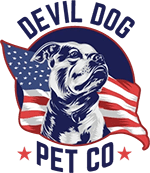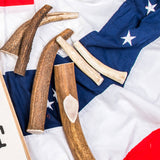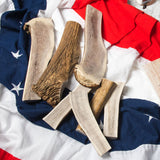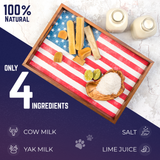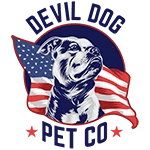Key Takeaways
- Dog antler ears are unique ear shapes that resemble branching antlers.
- These ear formations can occur naturally through genetics or be created with costume accessories.
- They feature upright positioning with splits, forks, or angular projections.
- The shape of dog antler ears mirrors the structure of actual antlers.
Table of Contents
- What Are Dog Antler Ears?
- Natural Dog Ear Shapes vs. Costume Antler Ears
- Caring for Dogs With Antler-Shaped Ears
- Health Risks and Prevention for Unique Ear Structures
- DIY Costume Antler Ears - Safety Protocol
- Extreme Dog Leadership and Responsible Ear Care
- Frequently Asked Questions About Dog Antler Ears
- Leadership, Responsibility, and Choosing Ethically Sourced Chews
- Final Recommendations for Dog Antler Ears
What Are Dog Antler Ears?
Dog antler ears refer to unique ear shapes that resemble branching antlers, either naturally occurring through genetics or created with costume accessories. These distinctive formations feature upright positioning with splits, forks, or dramatic angular projections that mirror actual antler structures.
If your dog enjoys enrichment, the Extra Large (XL) Whole Elk Antler Official Dog Chew is an excellent choice for larger breeds, providing a safe and long-lasting chewing experience that complements their unique personality.
Dog antler ears describe both rare natural ear formations with branching cartilage and popular costume accessories. Natural versions occur through genetic mutations or cartilage injuries, while costume antler ears provide safe seasonal fun when properly fitted and supervised.
The term originated in breed circles where judges and handlers noticed certain dogs developing ear shapes that deviated from standard classifications. Unlike traditional ear types, pricked, floppy, or semi-erect, antler ears display bifurcation or pronounced angular projections that create an antler-like silhouette. For smaller dogs, the Extra Small - Split Elk Antler Dog Chew - 2 Pack offers a perfectly sized, natural chew that supports dental health and mental stimulation.
Natural Dog Ear Shapes vs. Costume Antler Ears

Natural antler-shaped ears develop through cartilage irregularities, genetic variations, or injury recovery. These permanent formations require specialized care due to their unique structure and potential for debris accumulation in forked areas.
For a comprehensive selection of safe, natural chews, explore antler dog chews that cater to dogs of all sizes and chewing styles.
| Feature | Natural Antler Ears | Costume Antler Ears |
|---|---|---|
| Structure | Cartilage-based, permanent | Fabric/foam, removable |
| Flexibility | Limited, follows cartilage | Adjustable positioning |
| Care Needs | Daily cleaning, infection monitoring | Comfort checks every 15 minutes |
| Risk Factors | Debris buildup, hearing impact | Pressure points, restricted movement |
Costume antler ears offer temporary transformation for photos or holidays. Quality accessories use lightweight materials that don't compress the ear canal or restrict natural ear movement. Always remove after one hour maximum to prevent irritation.
Caring for Dogs With Antler-Shaped Ears
Dogs with natural antler ear formations need specialized cleaning routines targeting hard-to-reach crevices where debris accumulates. Use vet-approved ear cleansers applied with cotton pads, never cotton swabs that could damage delicate cartilage structures.
Inspect weekly for signs of infection: unusual odor, discharge, or swelling around fork points. Apply ear-drying powder within three minutes after baths, focusing on bifurcated areas where moisture traps easily. During humid weather or after swimming, increase cleaning frequency to prevent bacterial growth.
Marine-Level Precision: Set a weekly inspection schedule. Check each ear section systematically, base, middle, and tips. Document any changes in a log. Early detection prevents major problems that sideline your mission.
For more information on the safety of antler chews, read this detailed guide: are antlers safe for dogs.
Health Risks and Prevention for Unique Ear Structures
Antler-shaped ears face higher infection risks due to increased surface area and complex geometry that traps moisture and debris. Watch for persistent head shaking, scratching, or sudden changes in ear positioning, early warning signs of developing problems.
Prevent issues through consistent care protocols: clean ears twice weekly with veterinary-approved solutions, limit water exposure during baths by using cotton balls as barriers, and schedule professional ear examinations every six months. If ear shape changes rapidly, seek immediate veterinary consultation to rule out hematomas or cartilage damage.
DIY Costume Antler Ears - Safety Protocol

Create safe costume antler ears using lightweight foam or felt materials attached to adjustable headbands. Position accessories behind the natural ear flap, never compressing the ear canal or restricting blood flow. Secure loosely enough that you can slide one finger underneath the band.
Limit wear time to one hour maximum and remove immediately if your dog shows discomfort through repeated head shaking or pawing. Check for redness or irritation every 15 minutes during initial fittings. Never leave costume ears on unsupervised dogs who might chew or become entangled.
Extreme Dog Leadership and Responsible Ear Care
Understanding your dog's unique ear structure, whether natural antler formation or costume accessory use, demonstrates the ownership accountability that keeps dogs thriving in forever homes. Every structural variation demands adapted care protocols and consistent monitoring.
Support your dog's overall wellness with ethically sourced chews that promote dental health while you maintain their distinctive ears. Devil Dog Pet Co.'s naturally shed elk antler chews provide safe, long-lasting enrichment sized appropriately for your dog's jaw strength. These premium chews complement your comprehensive care routine, ensuring both mental stimulation and physical health.
Mission-Driven Choice: When you choose Devil Dog Pet Co.'s veteran-crafted chews, you support our commitment to keeping dogs out of shelters through responsible ownership education and premium nutrition tools.
For dogs who prefer a softer chewing experience, the Large - Split Elk Antler Dog Chew - 1 Pack is a great option, offering a satisfying chew with easier access to the flavorful marrow.
Frequently Asked Questions About Dog Antler Ears
Can ear shape impact my dog's hearing? Natural antler-shaped ears rarely affect hearing unless cartilage damage blocks the ear canal. The outer ear shape doesn't typically interfere with sound transmission to the inner ear.
Are antler ear shapes genetic? Most antler-shaped ears result from cartilage injuries or developmental irregularities rather than inherited traits. True genetic ear variations are extremely rare in domestic dogs.
How often should I clean uniquely shaped ears? Clean antler-shaped ears twice weekly with vet-approved solutions, focusing on crevices where debris accumulates. Increase frequency after swimming or in humid conditions.
Dog antler ears require understanding whether you're dealing with natural formations or costume accessories. Natural variations need specialized care protocols, while costume ears demand strict time limits and comfort monitoring. Both situations call for responsible ownership and consistent attention to your dog's wellbeing.
The key to success with any unique ear structure lies in consistent care, proper monitoring, and choosing quality products that support your dog's overall health. Whether managing natural antler-shaped ears or enjoying seasonal costume fun, your leadership determines your dog's comfort and safety.
For a deeper dive into the differences between antler types, see this comparison: deer antler vs elk antler for dogs.
Leadership, Responsibility, and Choosing Ethically Sourced Chews

Extreme Dog Leadership means taking full responsibility for every aspect of your dog's wellbeing, including understanding their unique physical characteristics like antler-shaped ears. Whether natural or costume-related, these ear variations require owners who commit to consistent monitoring and proper care protocols.
Your leadership determines whether unusual ear shapes become health risks or simply interesting traits. Daily inspections, proper cleaning techniques, and immediate response to changes separate responsible owners from those who react only after problems develop.
Extreme Dog Leadership Principle: "Every dog's success begins with a human who takes full responsibility." This applies equally to managing unique ear structures and providing quality enrichment through ethically sourced chews.
Antler Chews vs. Antler Ears: Clear the Confusion
Many owners confuse dog antler ears with antler chews, two completely different concepts. Antler-shaped ears are physical characteristics requiring specialized care, while antler chews are premium enrichment tools sourced from naturally shed elk antlers.
Devil Dog Pet Co.'s elk antler chews support your dog's mental and dental health through extended gnawing sessions. These Grade-A Rocky Mountain elk antlers are hand-selected, never chemically treated, and sized specifically for safe chewing. Always choose antler chews larger than your dog's muzzle width and supervise sessions regardless of your dog's ear type.
Quality antler chews provide the mental stimulation essential for dogs with unique physical traits who may require extra enrichment. The mineral-rich composition supports dental health while the extended chew time satisfies natural instincts without artificial additives or preservatives.
For medium-sized dogs, the Medium Whole Elk Antler Dog Chew offers a durable and engaging option that helps maintain oral health and satisfies natural chewing urges.
Commitment to Ethical Sourcing and Community Impact
Devil Dog Pet Co. fights for better dog-owner relationships through transparent sourcing and veteran-rooted values. Our naturally shed elk antlers support wildlife conservation while providing dogs with premium, chemical-free enrichment.
Every purchase supports our mission to keep dogs out of shelters by equipping owners with quality tools and educational resources. Whether you're managing a dog with unique ear structures or standard anatomy, our commitment remains the same: premium products that support responsible ownership.
Through partnerships with veteran organizations and rescue groups, we channel profits toward programs that place service dogs with veterans at no cost. Your choice to support ethical sourcing creates ripple effects that benefit dogs, owners, and communities nationwide.
Final Recommendations for Dog Antler Ears
Success with dog antler ears, whether natural formations or costume accessories, requires consistent leadership and evidence-based care protocols. Natural antler-shaped ears need twice-weekly cleaning with veterinary-approved solutions, while costume ears should never exceed one-hour wear times with 15-minute comfort checks.
The most critical factor is your commitment to daily monitoring. Changes in ear position, persistent odors, or signs of irritation demand immediate attention. Responsible owners prepare for these scenarios before they occur, not after problems develop.
Choose your dog's enrichment tools with the same attention to quality you apply to ear care. Premium, ethically sourced chews support overall wellness while providing the mental stimulation that prevents destructive behaviors, especially important for dogs requiring specialized physical care. For dogs who need a substantial and long-lasting chew, the Jumbo Whole Elk Antler Dog Chew is an outstanding choice.
When to Seek Professional Help
Contact your veterinarian immediately if natural antler-shaped ears show sudden changes in position, persistent discharge, or swelling around cartilage bifurcations. These signs may indicate infections that require professional treatment beyond home care protocols.
For costume-related issues, remove antler ear accessories at the first sign of head shaking, scratching, or avoidance behaviors. Red marks, indentations, or hair loss around attachment points signal improper fit or excessive wear time.
Professional grooming services familiar with unique ear structures can provide specialized cleaning and maintenance techniques beyond typical home care. Invest in expert guidance rather than attempting complex procedures without proper training.
Future Considerations and Long-term Planning
Dogs with natural antler-shaped ears may require modified care routines as they age. Senior dogs often develop increased wax production and reduced mobility for self-cleaning, making your consistent care protocols even more critical.
Budget for potential veterinary interventions related to unique ear structures. While most antler-shaped ears cause no health issues, the complex cartilage formations may require specialized treatments if injuries or infections occur.
Consider how your dog's ear structure affects their interaction with enrichment tools. Some shapes may influence how they position themselves during chewing sessions, requiring adjusted supervision techniques or modified chew presentation methods.
Whether managing natural antler-shaped ears or enjoying occasional costume fun, your extreme ownership mindset determines your dog's long-term comfort and health. Consistent care, quality enrichment, and immediate response to changes create the foundation for a thriving relationship regardless of your dog's unique physical characteristics.
For additional insights on antler chews and their benefits, check out this article: antler dog chews.
Frequently Asked Questions
What causes natural dog antler ears to develop, and how common are these unique ear formations?
Natural dog antler ears develop due to genetic variations, cartilage irregularities, or sometimes as a result of injury recovery that alters ear cartilage growth. These unique ear formations are quite rare and not commonly seen in most dogs.
How should I properly care for and clean my dog’s natural antler-shaped ears to prevent infections?
Care for natural antler-shaped ears by gently cleaning the folds and forks daily with a vet-approved ear cleanser to remove debris and moisture. Regular inspection for redness or odor helps catch infections early, and always keep the ears dry and well-ventilated.
Are costume antler ears safe for dogs to wear, and what precautions should be taken when using them?
Costume antler ears are safe when properly fitted and worn under close supervision to prevent discomfort or injury. Limit wear time to short sessions, check frequently for signs of irritation, and never leave your dog unattended while wearing them.
What are the potential health risks associated with natural and costume antler ears, and how can they be minimized?
Natural antler ears can trap dirt and moisture in their folds, increasing infection risk if not cleaned regularly. Costume ears may cause irritation or stress if ill-fitting or worn too long. Minimizing risks involves diligent cleaning, proper fit, supervised use, and prompt attention to any signs of discomfort or infection.
